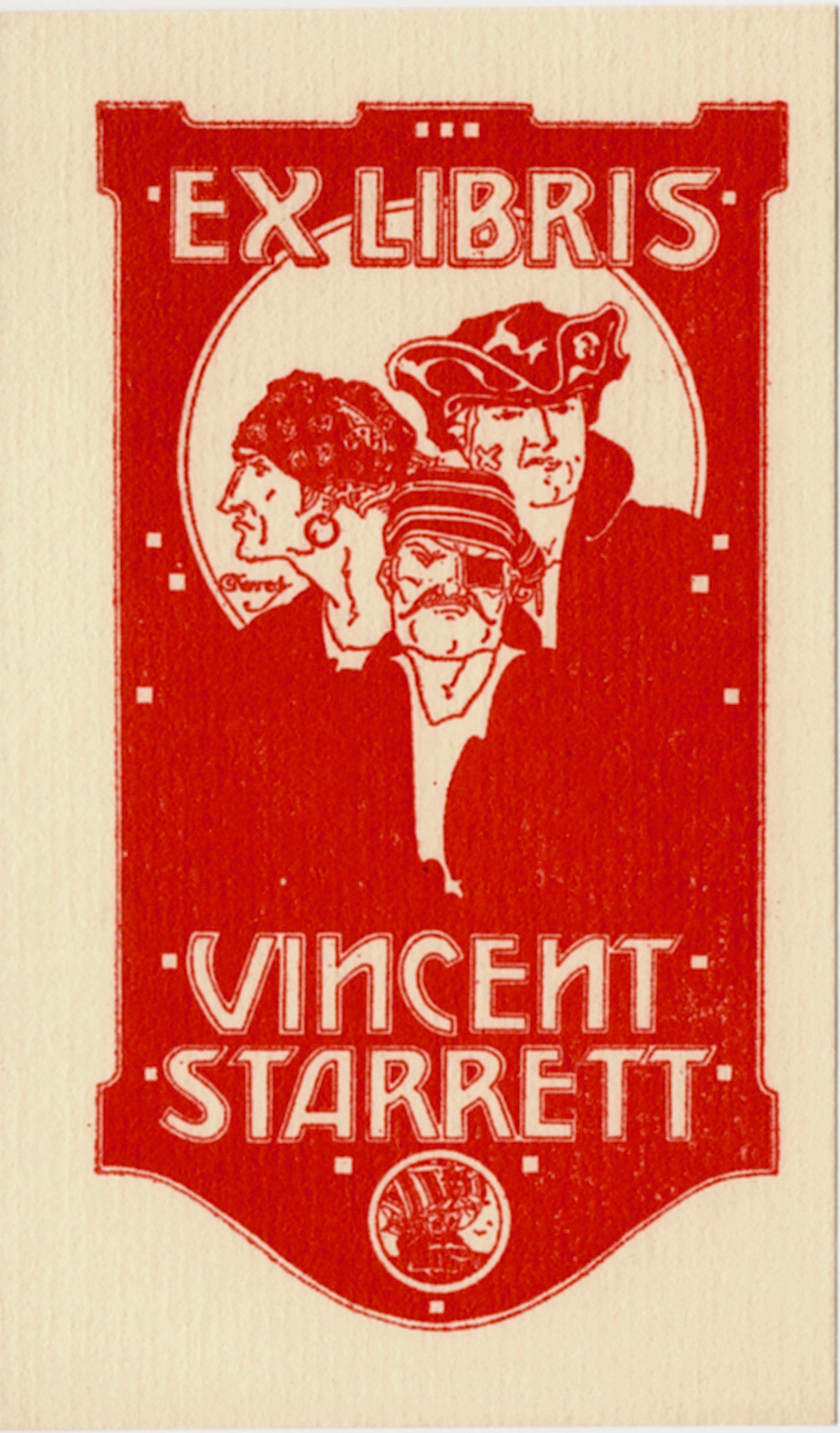Pirates, desert islands and mermaids.
Starrett's childhood fascination comes to life.
A section from Starrett’s essay on “Dead Man’s Chest” from the 1934 issue of The Colophon. More below.
Ahoy, me hearties!
Weigh anchor and hoist the mizzen!
We’ll be settin’ sail in search of pirates, desert islands, treasure and perhaps a lovely mermaid to take home.
Now show a leg and heave ho!
Treasure Island’s creator
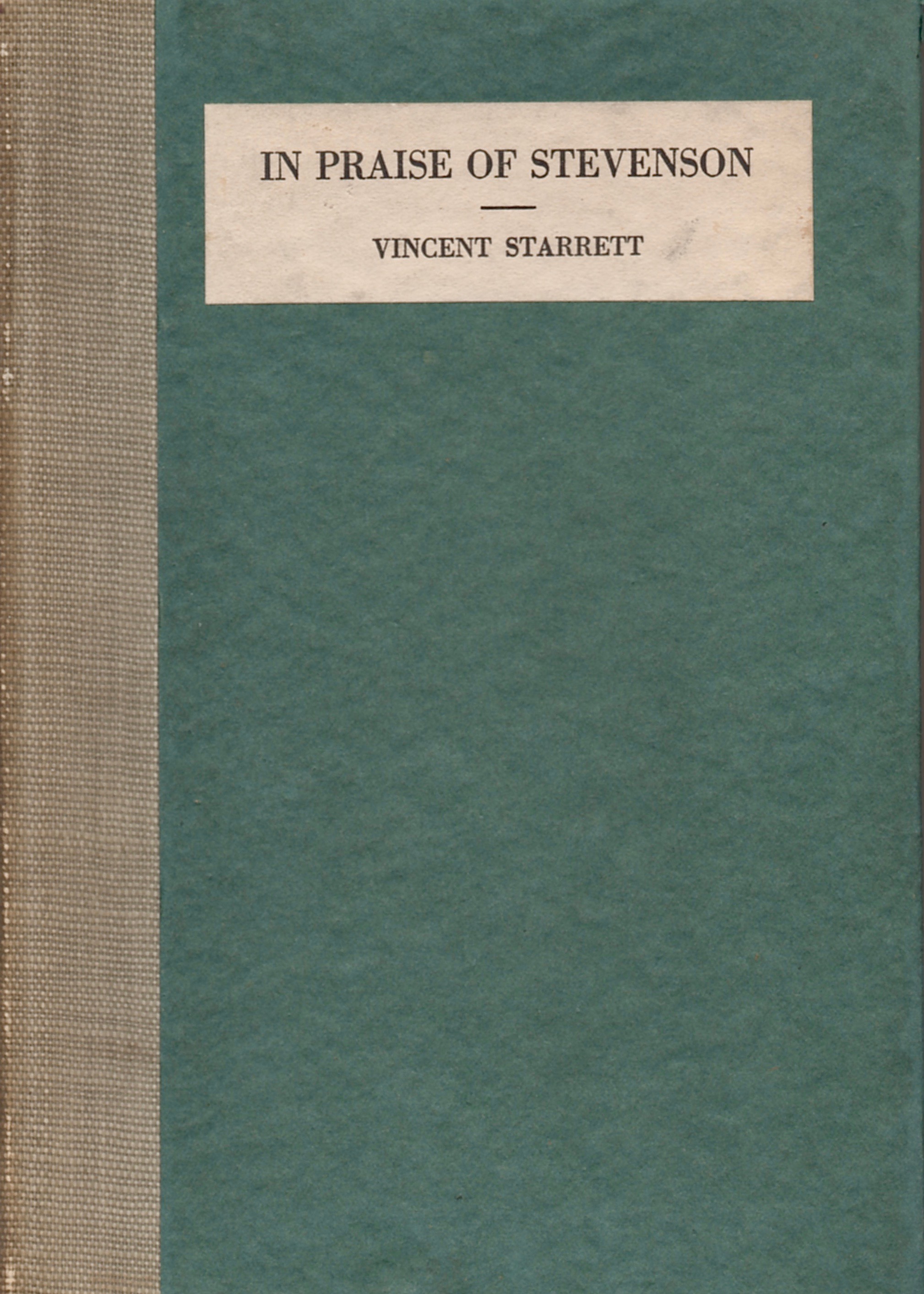
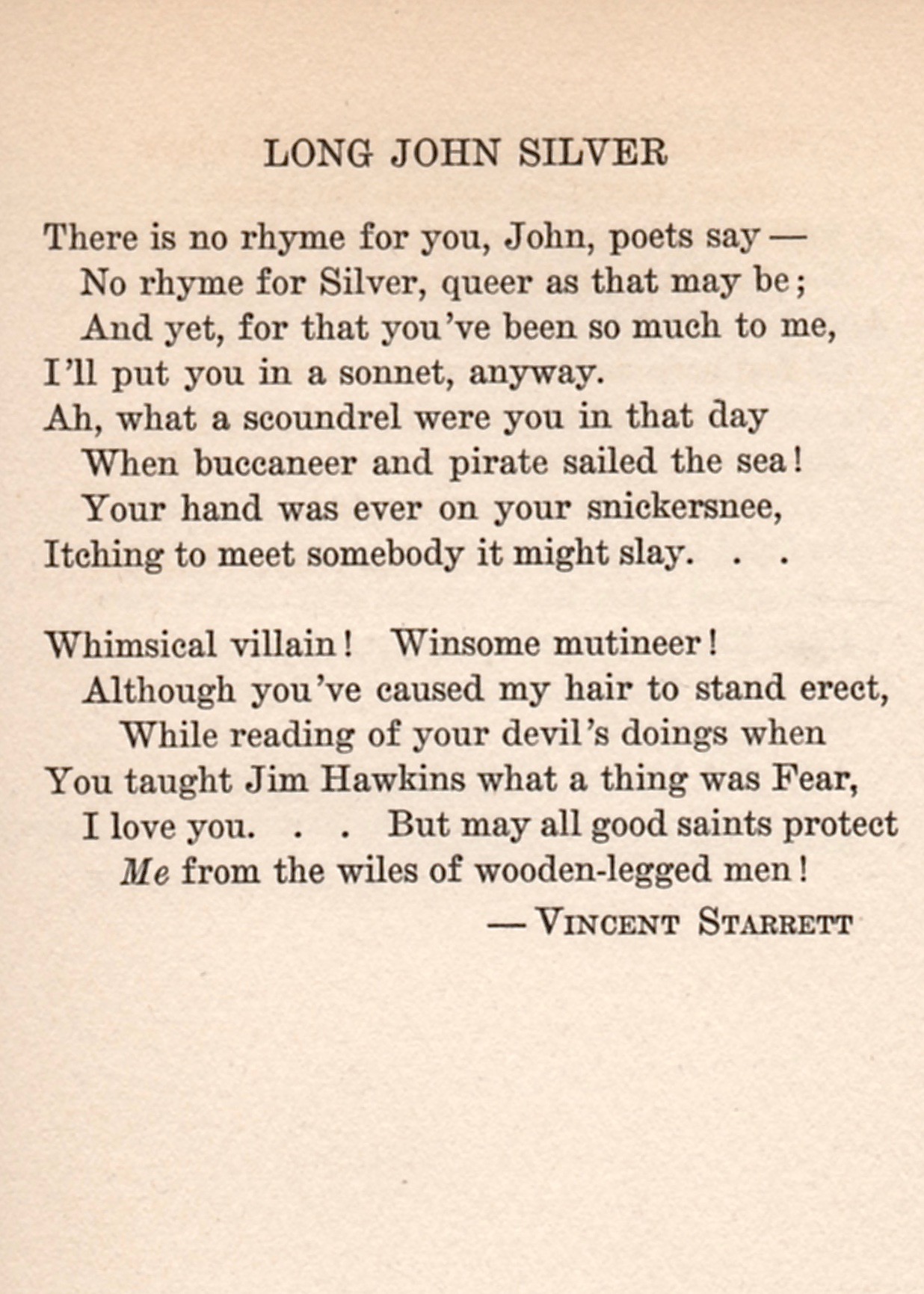
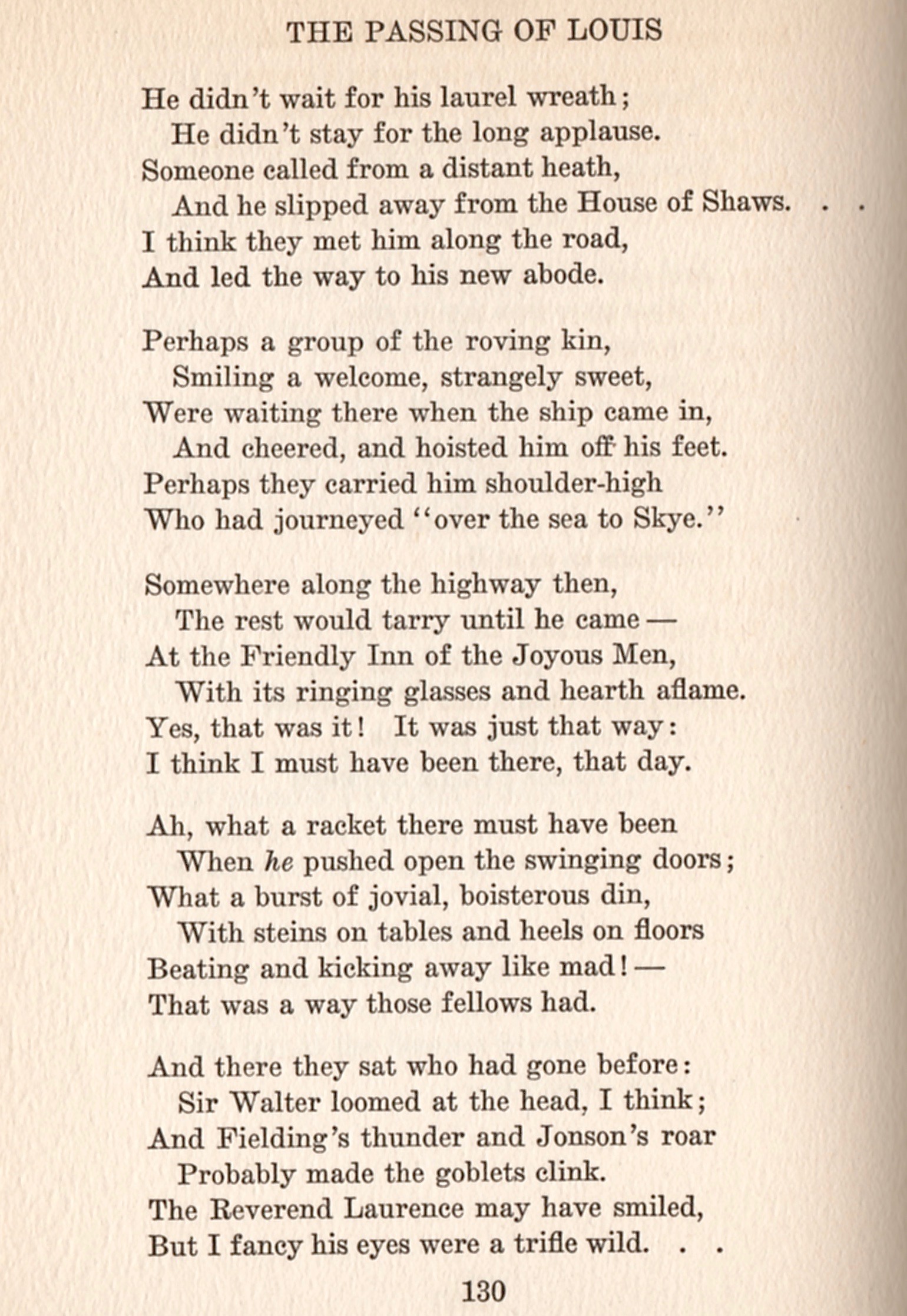
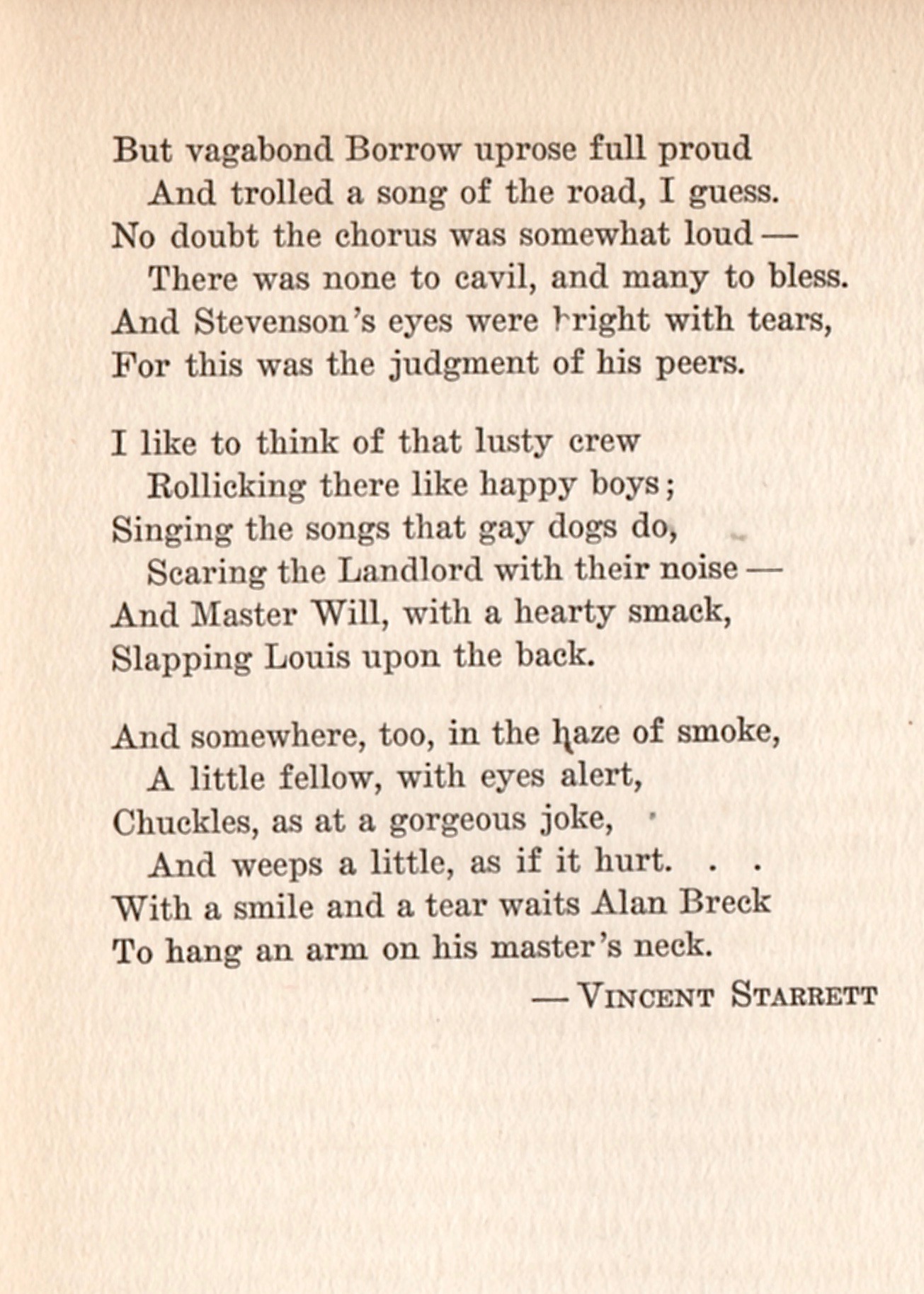
When Vincent Starrett was a lad, he spent endless happy hours in the children’s section of the Toronto bookshop his grandfather managed. Starrett writes lovingly of the experience and I believe he spent the rest of his life attempting to duplicate that innocent happiness through book collecting.
Several subjects emerged from these years that he would pursue for the rest of his life. Detective stories, certainly, were a staple. Adventure on the high seas was there too. Perhaps that’s how he came to spend so much time pursuing the works of Robert Louis Stevenson, whose Treasure Island is a classic of the genre.
Starrett inscribed this copy of In Praise of Stevenson with a verse from his poem to the author.
The first book Starrett edited was an anthology of verse dedicated to Stevenson’s impact and memory. In Praise of Stevenson, published in 1919 by The Bookfellows in Chicago, was Starrett’s labor of love, a way to pay back his childhood idol. Starrett did not hesitate to add his own contributions to the long list.
“The Passing of Louis,” imagines Stevenson entering a heavenly tavern where his writing colleagues cheer his crossing over. He’s a verse:
I like to think of that lusty crew
Rollicking there like happy boys;
Singing the songs that gay dogs do,
Scaring the Landlord with their noise—
And Master Will, with a hearty smack,
Slapping Louis upon the back.
Starrett’s also paid tribute to Stevenson’s most famous creation, Long John Silver, the pegged-legged, double-crossing, lovable rogue who steals the heart of Treasure Island and earns both him and his creator a place in literary history.
There is no rhyme for you, John, poets say —
No rhyme for Silver, queer as that may be;
And yet, for that you’ve been so much to me,
I’ll put you in a sonnet, anyway.
Ah, what a scoundrel were you in that day
When buccaneer and pirate sailed the sea!
Your hand was ever on your snickerance,
Itching to meet somebody it might slay . . .Whimsical villain! Winsome mutineer!
Although you’ve caused my hair to stand erect,
While reading of your devil’s doing when
You taught Jim Hawkins what a thing was Fear,
I love you . . . But may all good saints protect
Me from the wiles of wooden-legged men!
A Pause for Pirates

This is as good a place as any to mention Starrett’s pirates bookplate, created by Crystal Kennedy. Kennedy and Starrett were both members of The Bookfellows, the same group that published his Stevenson work.
The Bookfellows was a literary organization begun in March 1919 "to bring together in fellowship all the bookly minded people to the end that by their mutual support and encouragement great deeds might be performed."
I published this bookplate on the Studies in Starrett Facebook page a few months back and regular reader Harrison “Terry” Hunt suggested that the pirate with the X on his cheek was, in fact based on Starrett.
To help you make up your own mind, I’ve included a photo of Starrett here so you can flip back and forth and see if you detect a similarity.
Fifteen men . . .
But I digress.
A few years after his Stevenson book was published, Starrett collected a series of articles he had published in “Reedy’s Mirror,” a weekly newspaper popular in the Midwest at the turn of the century. The Reedy’s articles were collected into Buried Caesars, published in 1923 by Covici-McGee of Chicago.
Stevenson’s pirate tale was there too, in an essay entitled “Y.E.A. and a Bottle of Rum.” In his article, Starrett puts together various explanations for the origins of the pirate’s song that has entered the popular lexicon:
Fifteen men on a dead man’s chest,
Yo-ho-ho, and a bottle of rum!
Drink and the devil has done for the rest,
Yo-ho-ho, and a bottle of rum!
While Stevenson’s family made it clear he had invented the rhyme, others came along to either claim it as their own or to embellish the original. Starrett’s article looks at the legends surrounding the quatrain and how its lusty imagery brought to life the “puppets of an invincible invalid who invented and wrote about pirates because it was neither expedient nor possible to be one himself.”
By the way, Stevenson picked up a part of the rhyme from a book called At Last: A Christmas in the West Indies by one Charles Kingsley, who recorded a passage about “The Dead Man’s Chest,” a dangerous reef where pirates gave up their lives.
. . . on a Dead Man’s Chest
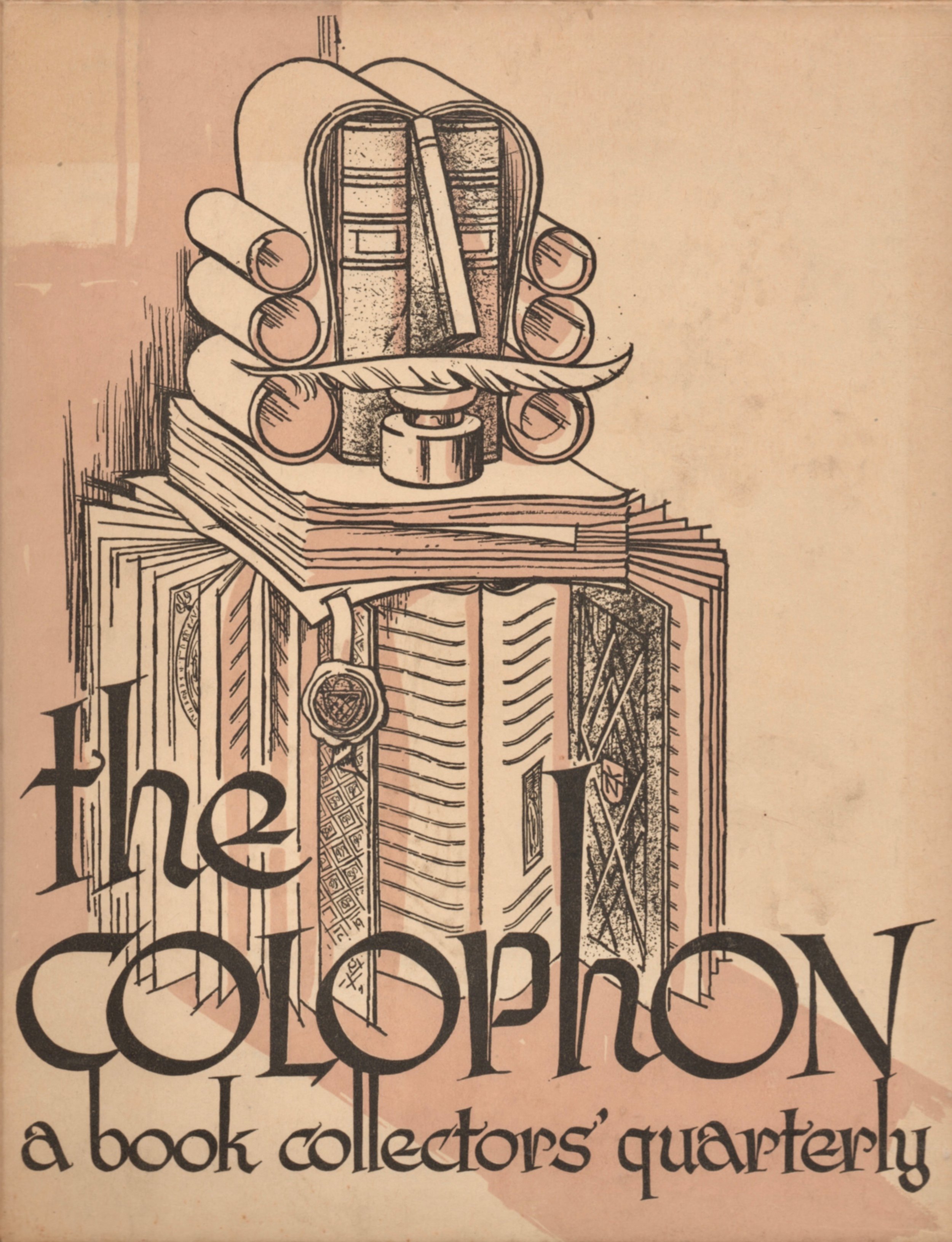
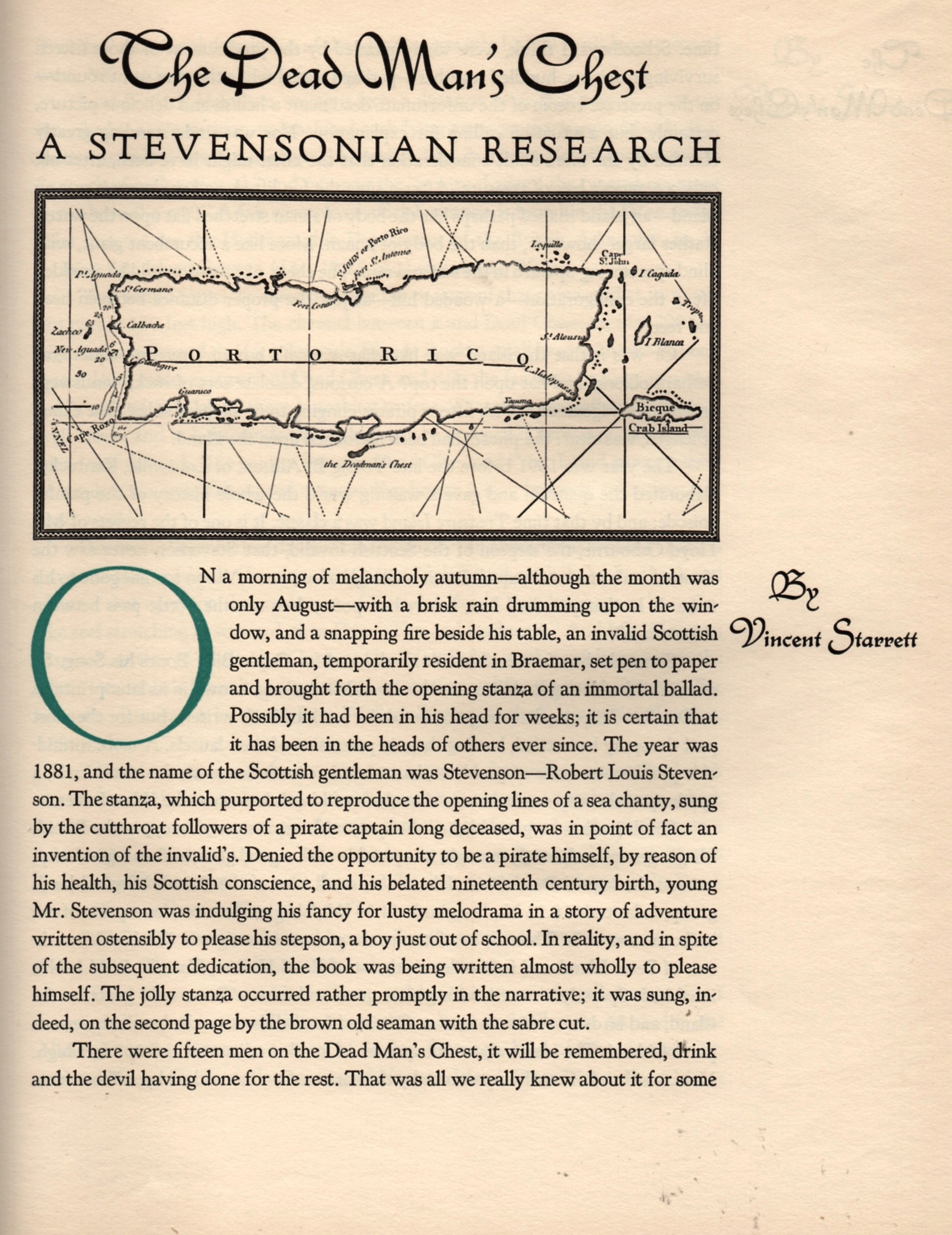
Having enjoyed himself on the topic, Starrett revisited Treasure Island again in a 1934 article for The Colophon, Part Seventeen, a quarterly publication for book lovers whose contributing editors included Christopher Morley.
(The issue holds another treasure: “The Dates in The Red-Headed League,” by Dorothy L. Sayers. It’s one of the few rare times when Starrett and Sayers appeared together in an anthology.)
“The Dead Man’s Chest: A Stevensonian Research,” lead the issue, with a handsome map of “Porto Rico.” Starrett revisits the pirate’s song, with special attention to “The Deadman’s Chest,” which turns out to be a dangerous bit of land and sea: “A small islet of the British Virgin Islands group.” Sailors of the 1800s speak of its “coffin-like reef” which presents dangers to the unwary ship captain.
Other references—which could be to this rock or others nearby, Starrett is uncertain—says its appearance is of “a great shrouded corpse stretched flat upon the sea.”
Whichever legend you choose to believe, the fact is that there is, to this day, an uninhabited island called Dead Man’s Chest off the southern coast of Puerto Rico. And, for those of us sitting on dry land thousands of miles away from its danger, that’s a rather pleasant crossover between fiction and fact.
The Ballad of Brobdingnag
Starrett also occasionally discussed imaginary islands in his Chicago Tribune column, “Books Alive.” There was, for example, Lilliput Island, “with its neighboring islet of Blefuscu, somewhere off the coast of Australia.”
Starrett admired Jonathan Swift’s tales of Capt. Lemuel Gulliver. Swift
A very rare copy of Starrett’s “Ballad of Brobdingnag,” a mildly naughty fantasy based on one of Gulliver’s travels at sea.
“wrote one of the great satires of literature which, by an irony greater even than his own, has become for most people only a child’s wonder book. Yet I suppose it is true that much of the author’s satire is as applicable to human society today as it was in the eighteenth century. There is still a wonderful bitterness in the old book for anybody who for any reason happens to be annoyed with his fellow men.”
Which brings me to something a little naughty. Starrett wrote a fantasy ballad based on Gulliver’s time on Brobdingnag, where giants rule and mere men are like toys to the giant women who live there.
An ‘academic and literary interest’ in mermaids
Here’s the column as it appeared in the Tribune.
Speaking of fantastical creatures, let’s finish out with mermaids, shall we? Not those “under the sea” mermaids that have been Disney-fied and drained of their sexual allure No, these are the mermaids who turn sailors heads and sometimes led to bad endings.
Those of you who have been with us for a while know that artist Fridolph Johnson created a couple of wonderful bookmarks for Starrett, including the famous image of Sherlock Holmes smiling at the viewer.
The mermaid manuscript

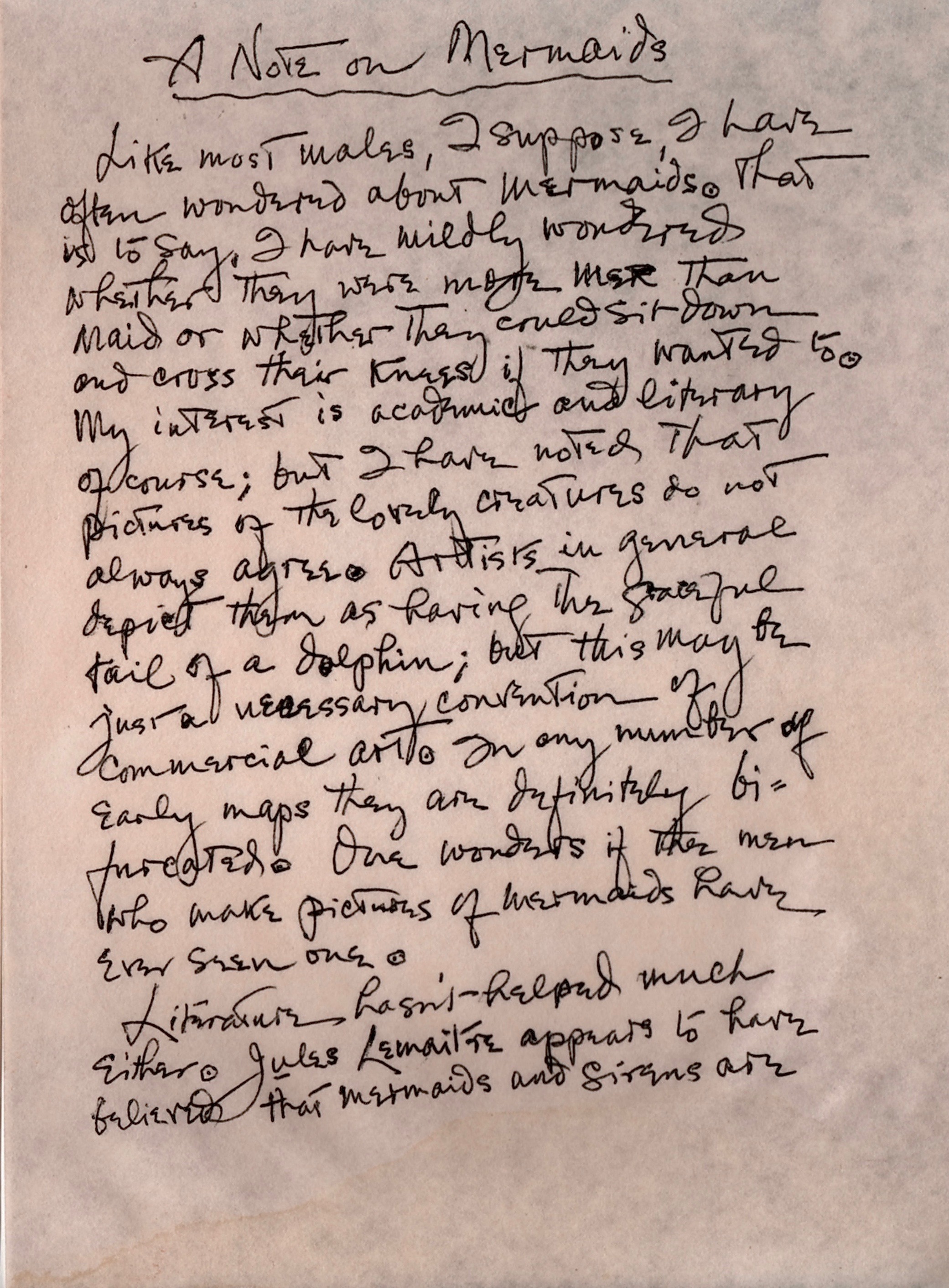
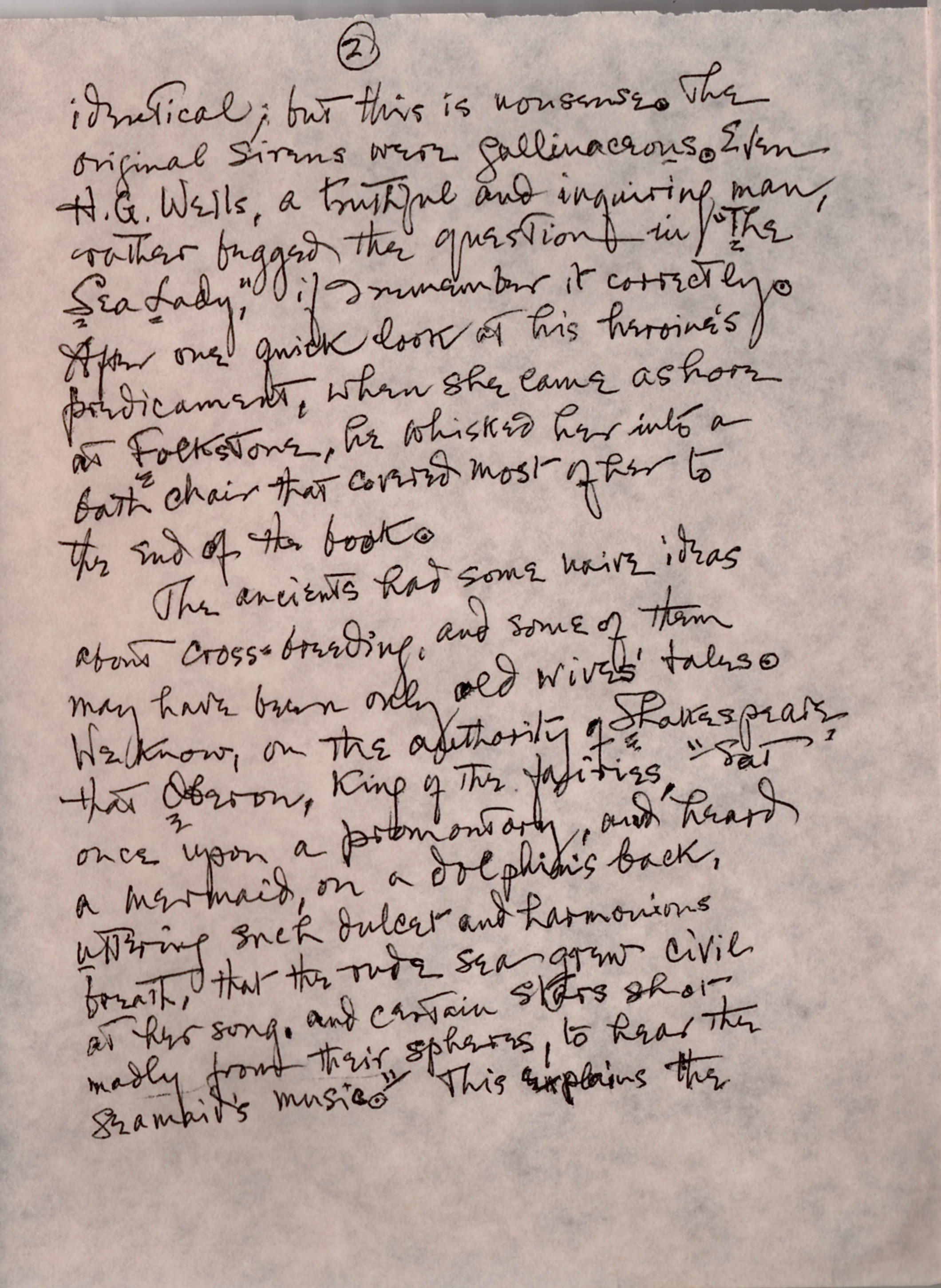
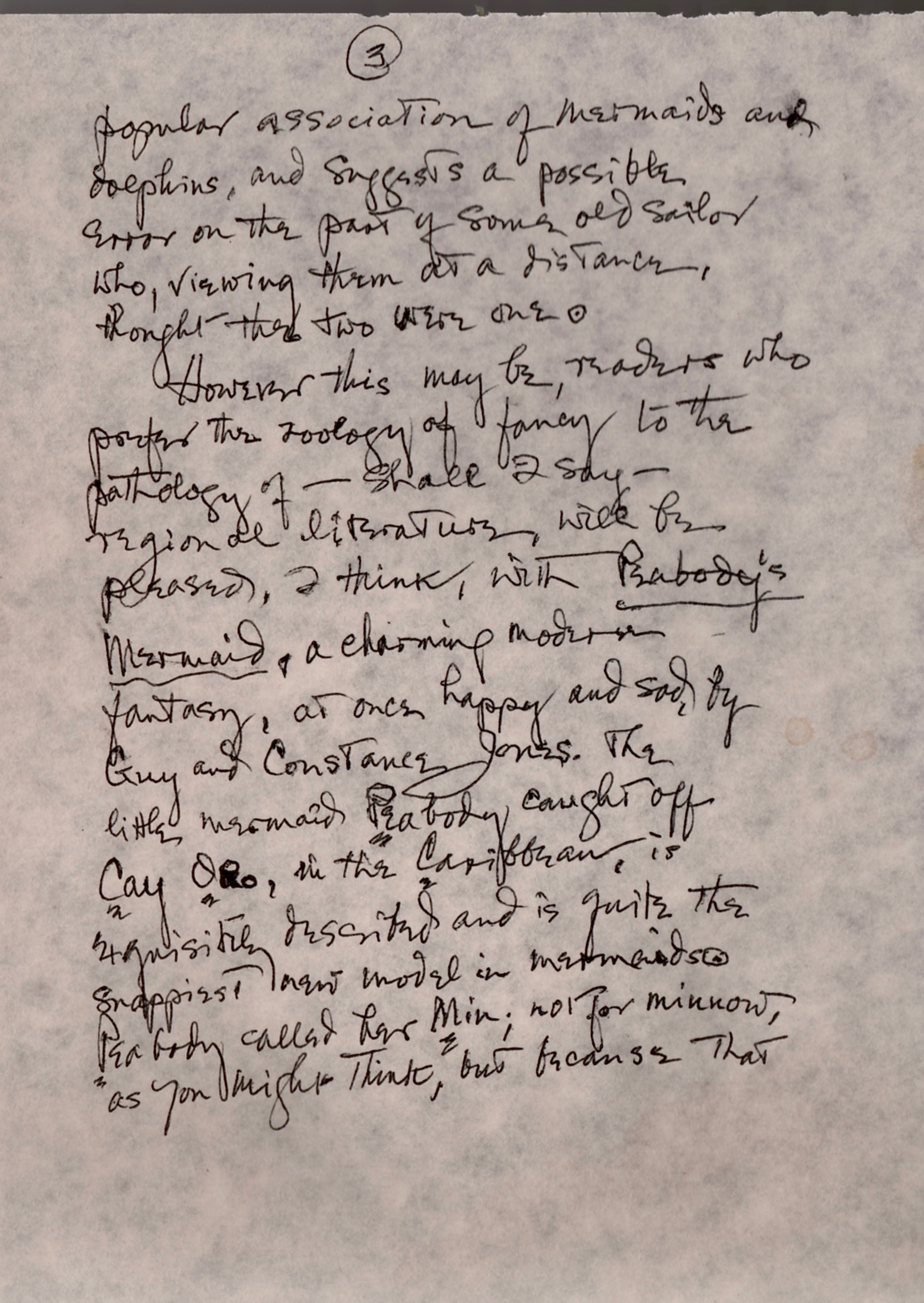
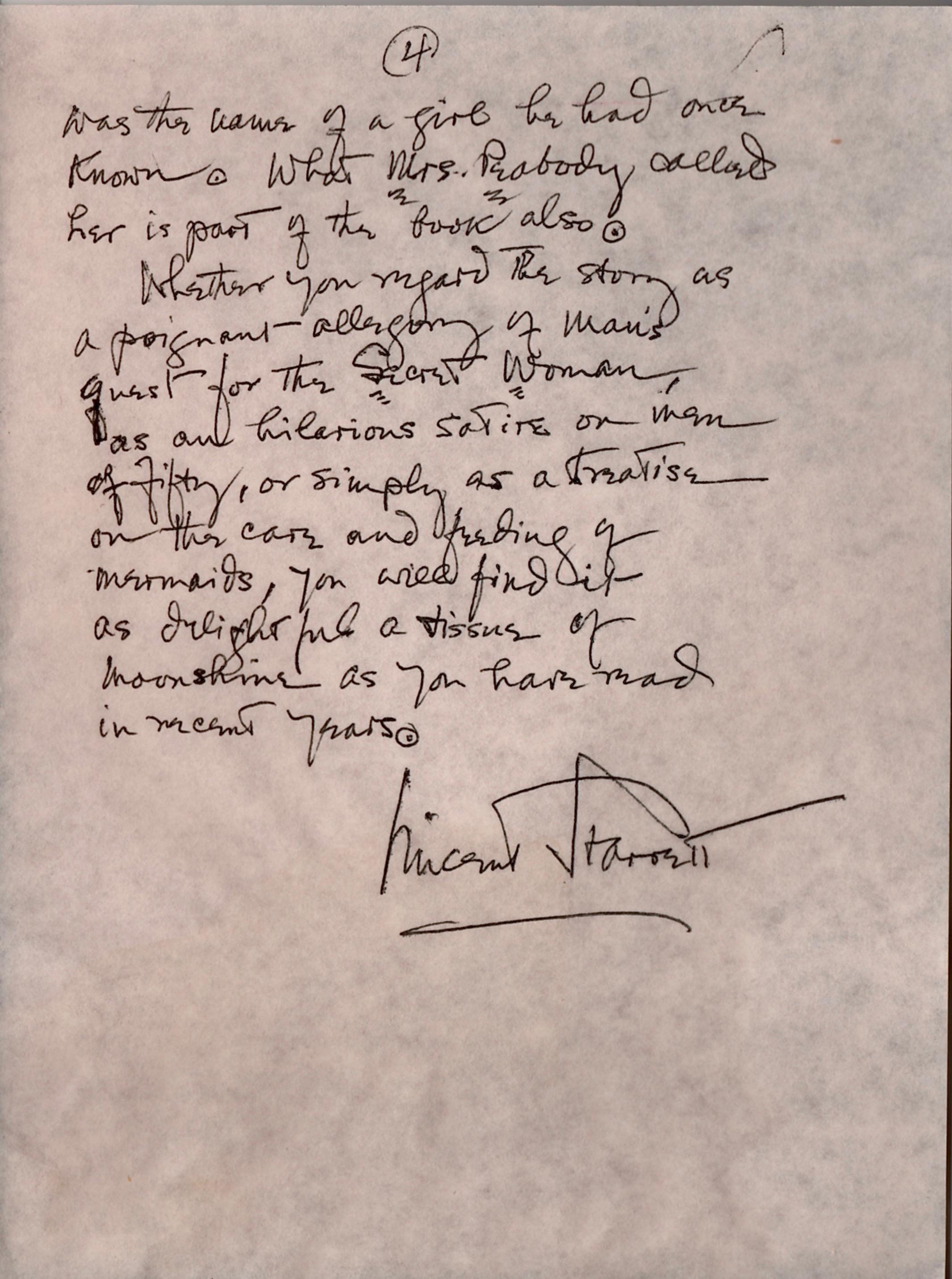
Johnson was fascinated by mermaids and called the little press that he issued publications from The Mermaid Press of New York. Starrett wrote an essay about mermaids for his “Books Alive” column for May 12, 1946 in the Chicago Tribune, then reprinted the essay in his 1947 anthology Books and Bipeds (New York: Argus Books Inc.).
Many years later, Johnson asked Starrett for a copy of the column in Starrett’s own hand. Starrett agreed with the document you see above. For those who don’t want to strain through Starrett’s handwriting, a copy of the column is also included here.
The paperback movie tie-in edition of “Peabody’s Mermaid.”
Peabody’s Mermaid
As you can see, Starrett took the opportunity to link speculations on mermaids from himself and others with a fantasy written by Guy and Constance Jones, called Peabody’s Mermaid. (The book proved quite popular and the couple wrote a followup about how a man’s life was interrupted by a leprechaun. The book would be made into a 1948 movie starring Tyrone Power, "The Luck of the Irish.”)
Peabody’s Mermaid proved to be as popular as Starrett predicted, and was made into a Universal film in 1948, renamed “Mr. Peabody and the Mermaid.”
Written and produced by the highly prolific and talented Hollywood triple-threat Nunnally Johnson, the film starred the lovely Ann Blythe and the aging but still debonair William Powell.
Here is where we set anchor and go ashorrrrre.
Arrrrgh.


